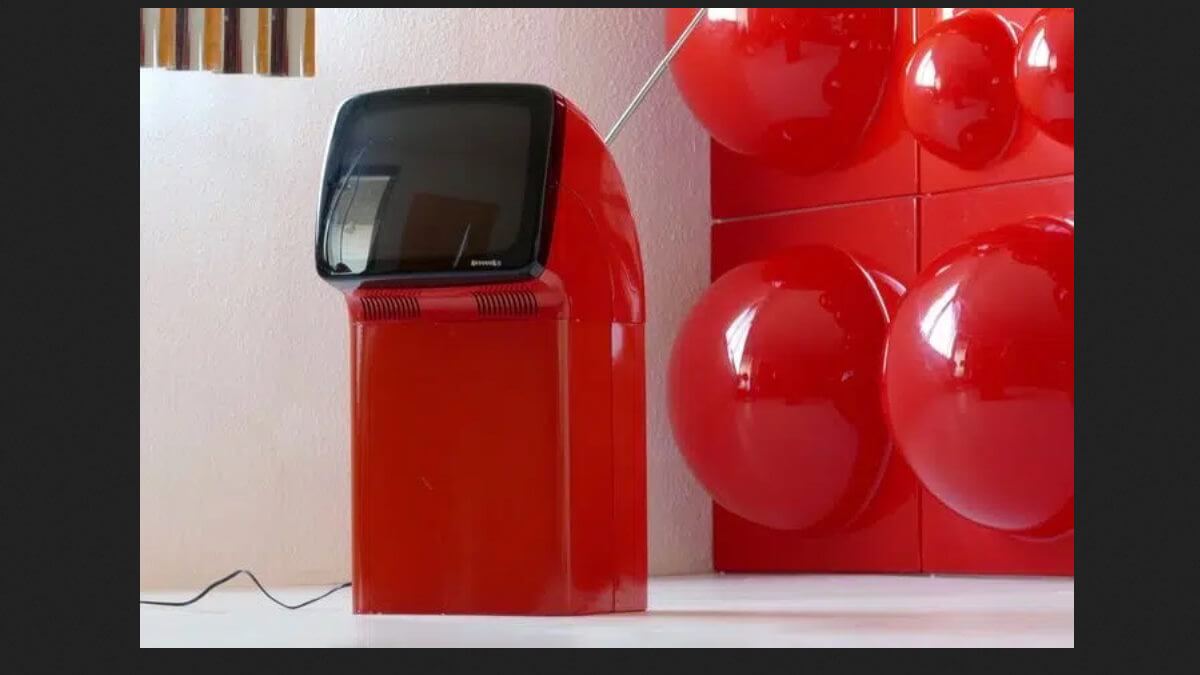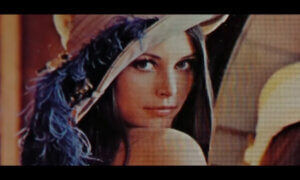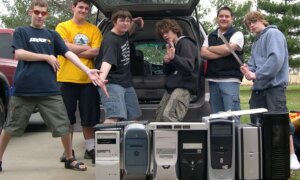In part one of this series about the evolution of TV, we answered the question of “when did TVs come out” and explained some of the various technologies of TV. Now, we chronicle the evolution of TVs through the decades, for your viewing pleasure. If you’re a history buff, you’ll definitely find some conversation pieces here.
1920s TV – we called it “televisor” and the screen was the size of a postage stamp
1920s was still the time of radio. While TVs were being developed all over the world, it took until 1929 for the first commercial TV set to hit stores.
It was the Baird Televisor and its screen was so small, it was about the size of a postage stamp. Still, the price of the first TV was equivalent to about 6 months of salary for a person earning an average wage, so it was a luxury reserved only for the rich.
Here’s how it looked to watch the first TV in history, basically. It’s a bit of a nightmare fuel since it’s black and white and unclear, but consider what a wonder it must have been back then!
The first known photograph of a moving image produced by Baird’s “televisor”, as reported in The Times, 28 January 1926 (The subject is Baird’s business partner Oliver Hutchinson.), via Wikipedia
The Scottish inventor John Logie Baird was its maker – the same man who also brought us color TV way before we had the means to manufacture the technology at scale. Baird had created a worldwide buzz by demonstrating the world’s first live working television system on 26 January 1926. By 1928, Baird had also achieved the first transatlantic television transmission. As for the Baird Televisor, it truly shows the genius of the man who built it – too bad he’s not so well known today!
1930s TV – the Great Depression alleviated by a wonder box
The Marconi 702. In the history of TVs, nothing made an impact quite like the Marconi 702, which went on sale in the middle of the 1930s and was an incredible piece of engineering.
The Marconi 702 TV was a vision-only, mirror-lid TV that used magnetic deflection and electrostatic focusing. What does that mean?
It means that it did not work at all like a TV from 2023. When you switched on this 30s TV, the image on the horizontal 12-inch screen was reflected onto the mirror on the lid of the case, and that’s how you watched anything.
To understand just how rare these oldest TVs are, here’s a nifty comparison from Extravaganzi:
“There are more 18th century Stradivarius violins in existence than pre-war TVs and this set has only had two owners.”
Here’s a look at the oldest TV still in use, the Marconi model 706, to better understand what it was like back in the 30s.
Part 2. The Oldest Television TV still in service. Marconi EMI model 706 904. – YouTube
1940s TV – manufacturers were banned from making TVs but still produced some beauties
Did you know that back in the 40s making TVs was banned? Because of WWII, manufacturing of TV equipment was mostly banned because the military needed the cathode ray tubes that produced the pictures for making radars.
Because of this, in the 40s having TV was an incredible sign of wealth, even though TVs back then look nothing like we’d expect today.
Most TVs in the 30a had tiny picture screens, advertised with diagonals of 10 to 15 inches – less than some tablets today.
Still, that didn’t stop TV manufacturers from going all out and crafting some beautiful pieces.
Take a look at the Admiral Triple Thrill TV – it would still look incredible today in pretty much any home decor. Yes, it even had space for leather-bound books!
Even TV brands back then do not sound familiar to modern watchers. Models like the 1948 Admiral 19A111, 1948 Airline 94GSE3015A, 1949 Crosley 9-420M, and the 1947 Du Mont RA1021 were all the rage.
If you thought lugging your iPad to the beach was cumbersome, imagine in the 40s you had to drag on a Motorola suitcase TV.
Other TV manufacturers included Emerson, Farnsworth, Hicrafter, Motorola, Philco and Raytheon. Yes, the same company today known for making military equipment made TVs back then, almost a century ago.
Why were round TVs a thing? We’ll explain in a minute.
If you’re curious about the old brands, the history of Admiral is a fascinating read.
1950s TV – the history of television as we know it starts here
The 1950s was a pivotal time for television.
As the world was starting to rebuild from World War II’s generalized destruction, people took comfort in gathering together to watch tv. Many classic shows that are still beloved today showed up on 50s TV sets, including the timeless I Love Lucy with Lucille Ball and Father Knows Best.
For a true dip into the history of television, I recommend trying to stream the Roy Rogers Show, a western TV series whose impact is still felt in modern movies. Either way, the 50s TV shows are a great way to see how the world recovered from WW2 and get a glimps at the social and cultural shifts from that time.
As for the design of 1950s TV? This is truly the golden age of television.
50s TVs often came in huge, wooden console cabinets that became the centerpiece of the living room. Even though the TV screen was small, many of them also came in with built-in radio tuners and record players.
Here are some of the most beautiful and popular TVs in the 50s.
Zenith Black Magic TV from 1950 had a reflection-proof screen, offering almost life-like pictures without glare and blur.
Even though it was still a black and white TV set, the Philco Predicta was the first swiveling TV, with a thin picture tube and a look straight from the Jetsons.
Zenith Console Television Porthole was a mouthful and the specs matched the long name. It had a round TV screen (they called them porthole screens), a record player and a radio.
Why round TVs? This form factor has long since been abandoned but there was a good reason why round TVs were a thing.
“The cheapest and easiest way to manufacture a CRT was to make it round. But the aspect ration of 4:3 lends itself to a more rectangular design. The CRT slowly evolved to being essentially rectangular in shape but it had rounded edges because it was a glass tube. You could not create a perfect rectangle using the process that created the glass cathode ray tubes in the early days of television,” explains GeekHistory.
Still, most people in the 50s had either a General Electric Company TV, called a Gec TV, or and Emerson Console, featuring radio tuners, phonographs and, of course, any choice of wood grain you could think of.
Anyone else loving the Fallout vibe?
1960s TV
It wasn’t just flower power hanging out outdoors in the sixties. Here is where the exciting history of television begins basically, because ,by the end of the 1960s, nearly 95% of Americans had a TV set in their home, and the same number goes for the UK as well.
Why?
It was in the 60s when the remote control was invented and a new way to relax gained hold over everywhere.
Take a look at this beautiful vintage remote control, RCA Victor TV remote, a minimalist wonder tool with just seven buttons. Don’t know about you, but I’d give up all my streaming apps for a chance to own one of these beauties. That scifi design! FIY, if you love vintage TVs and gadgets, you can frequently find a vintage remote on eBay for a lot less than it cost back then (think $50-150)
The increase in TV watchers was also reflected in the number of shows, the diversity of them and, of course, color TV. All this gathered such a momentum that, by the end of the 60s, it was also the end of the drive-by cinema era.
What were people watching at home? In some regards, the programming back then does sound a lot more exciting than what’s on today, and not just because of the current Hollywood strikes.
Between 1964 and 1972 everyone was watching Bewitched, a comedy series about a witch married to an ordinary man, who couldn’t stop using magic to solve everyday family problems.
If you got yourself a retro TV and want to watch it like in the days gone by, I highly recommend The Beverly Hillbillies. This show ran between 1962 and 1971 and it was basically The Fresh Prince of Bel-Air, 60s style. The Beverly Hillbillies was the story of a nouveau riche hillbilly family that moves to Beverly Hills and shocks privileged society with their lifestyle.
Of course, you can also watch the original Addams Family, another super-popular TV show in the 60s. The beloved quirky family first appeared on the small screen (and they were super-small back then!) in 1964 and ended its run in 1966.
Oh yeah, and take a look at the gorgeous Pye Musical TV, an example of a vintage TV that definitely filled a niche.
“This wind-up musical T.V. is designed to play a tune whenever handset of a telephone rested upon the top of the set, providing the customer on the telephone to “enjoy” some music whilst the shop owner wandered off to look something up or see if a part was in stock. The short duration achieved when fully wound meant that the shop keeper had better be quick !”
1970s TV
Although color TV was introduced earlier, it actually became popular in the 70s, as prices went down. In the UK, channels you still enjoy today got their big break – BBC One and ITV started broadcasting in color by 1969, so by 1970, viewers had three color channels to choose from: BBC1, BBC2, and ITV.
Another exciting development in the history of television is the introduction of the Home Box Office – you know, HBO, now the prestige network home to some of the best TV shows in history.
What’s most interesting though is that the introduction of color TV actually led to an increase in popularity for black and white TVs. Since that now almost antiquated technology got cheaper, many families now started having more than one TV in their household.
Plus, all that space age design!
Take a look at the JVC Videosphere, a space helmet TV set that would look amazing relaunched today.
In the 70s, futuristic TVs lived side by side with wooden TV sets with impressive details. What a time to shop around!
TVs from Quasar were incredibly popular from the 60s and to about the early 80s.
1980s TV
In the 1980s, some of the most popular brands included Sharp, Goldstar, Sony, Panasonic, Zenith, Fisher, and Mitsubishi. The specs of 80s TVs? If you had the latest tv set back then, you’d probably show your friends its Auto Fine Tuning and Cable-Ready capabilities. As for the TV design, it would have looked kind of like this.
Vintage TVs from the 80s look just as amazing as the retro headphones of the time – it was an exciting period brought on by the popularity of both colorful plastics and natural wood grain.
As for how much a TV cost in the 80s, the answer is “it varies”.
An ad for the perfect vintage TV, the Pye Red Box
Yes, the prices had come down as the technology matured but it wasn’t like today, where you can walk into a store and come out with a $200 55-inch TV – the screens were small.
Take a look at this page from People’s History for a list of consumer goods prices in the 80s and check out just how creative TVs were back then.
For $80 you could buy a tiny clock radio TV but if you wanted a high-end stereo sound TV you’d have to pony up as much as $700.
A Sony SuperBeta HiFi theater, aka an entertainment center with a TV and high-end speakers? About $1500. A home entertainment center complete with a “computerized” remote control? $5000.
Via ClickAmericana
Still, 80s TV is still some of the best entertainment you can still watch today, with incredible dramas and comedies that still stand the test of time. This site has some of the best 80s TV shows compiled in a list, and we highly recommend you don’t just stop at M.A.S.H. or Roseanne. If you’re there, give The Jeffersons and Laverne & Shirley and Chance!
1990s TV
The 80s were an exciting time for technology and entertainment, no doubt about it.
Fast forward to the 90s and prices had dropped even further, but aesthetics followed a similar downward trend.
If in the previous decades TVs doubled as furniture, luxurious furniture at that, by the 90s the grey box trend was in full swing. To drive prices down, TV manufacturers had to streamline design, and the result was an uniformity of look that’s still prevalent today.
Yes, they went from bulky to sleek, but that retro look is something that’s sorely missed.
What about you, what was your first TV like? Any fond memories?
Follow TechTheLead on Google News to get the news first.























